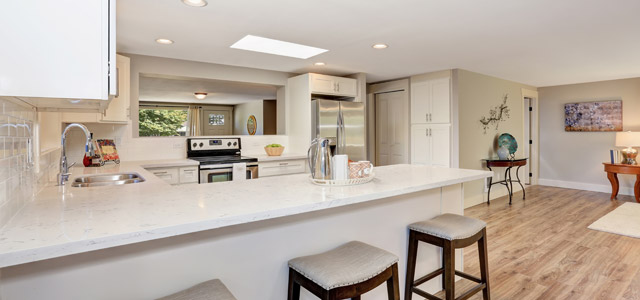There are many beautiful materials to choose from when picking your next countertop. Engineered quartz and marble are two popular choices. Each has a rich, elegant look and works well with almost any style of home. Due to the durable nature of each material, this is an investment that lasts. Knowing more about each type of surface makes your decision easier.
Overall Aesthetic
Engineered quartz countertops, including those made with Silestone Natural Quartz, have a uniform appearance. Each slab of Silestone is engineered to meet consumer or manufacturer specifications. As a result, large slabs of consistent Silestone are available. This makes it easy to give your countertops a coherent, uniform appearance. Silestone comes in numerous shades, so you can find one that matches or compliments your existing décor.
Marble counters have a lot of natural variation as part of their charm. While this may work in some homes, it is a distracting design element in others. Some people prefer to use marble in moderation, as a backsplash, or minor focal point, rather than in excess. Silestone is a great compliment to marble or granite surfaces. Pairing natural stones together can be tricky, but when done properly it can tie your kitchen or bathroom together perfectly.
Durability And Longevity
Engineered quartz counters are incredibly durable. They are nonporous and non-absorptive, making them perfect for busy kitchens and bathrooms. Quartz is naturally chip, dent, and scratch resistant. Busy families and avid cookers, in particular, enjoy these qualities. Due to its durability, engineered quartz lasts a long time, making it a good investment for any homeowner. If you plan on selling your home in the near future, an engineered quartz counter is a great selling feature. Silestone is also heat resistant. It does not burn nor stain after coming into contact with hot items such as pots, pans, or cooking utensils.
Marble is another very hard surface made with natural stone. Unlike engineered quartz, it is more susceptible to damage from chips, dents, and scratches. If you opt for a marble counter, keep an eye on its condition. Minor chips and scratches are easy enough to repair if caught early. Homeowners do not need to be so vigilant when it comes to engineered quartz.
Maintenance
The biggest difference between marble and quartz is the amount of maintenance involved. Engineered quartz is easy to maintain. After installation, all a homeowner needs to do to keep it in good condition is to wipe it off after use with warm water and mild soap. Most homeowners use dish soap and a microfiber cloth. Silestone, and other engineered quartz surfaces, do not require periodic resealing or polishing.
Marble is a bit harder to care for over time. Since it is a porous surface, you need to seal it after installation and once every two years after that. Marble stains a lot faster than quartz, making it important to wipe up spills immediately after they happen. Ask the manufacturer about specific care and cleaning instructions if you purchase marble surfaces. You may need specialized cleaning products to keep it in good condition.
Both marble and engineered quartz have their benefits. They each look beautiful and bring a rich, elegant look to any home. Marble and quartz are also versatile, working well with any home style and décor. Silestone and other engineered quartz brands are perfect for busy homes. Homeowners who lead busy lifestyles or who have pets and children may want to invest in a lower maintenance countertop, like quartz. Marble is ideal for those who have time to spend on their counters. Installing it as a backdrop to compliment an existing quartz counter is a great way to incorporate it into your décor.


